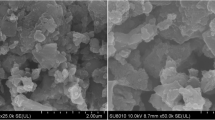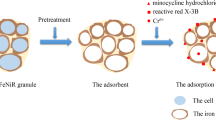Abstract
The properties of sewage sludge-derived biochar (BC) pyrolyzed at 300–900 °C were characterized, and which exhibited the basic properties of coagulant. When 1 g BC500 was added to 100 mL waste-activated sludge (WAS), the maximum mean settlement rate reached 8.20 mL min−1 within 10 min, and the volume of the settlement with settling time decreased to 13 mL. The capillary suction time of BC500 (12 s) was superior to those of municipal solid waste incineration (MSWI) fly ash (13.40 s), coal fly ash (14.20 s), and activated carbon (12.20 s). In addition, added BC may reduce the moisture content of sludge cake, especially for BC500. It can be that soluble cations and organic functional groups neutralize the negative charge of WAS which is helpful to shorten settling time. Meanwhile, the pore structure is beneficial for reducing moisture content of sludge cake. As results shown, BC was feasible to improve sewage sludge dewatering used as a coagulant.









Similar content being viewed by others
Abbreviations
- V :
-
Volume of the settlement with settling time
References
Thipkhunthod P, Meeyoo V, Rangsunvigit P, Rirksomboon T (2007) Describing sewage sludge pyrolysis kinetics by a combination of biomass fractions decomposition. J Anal Appl Pyrolysis 79:78–85. https://doi.org/10.1016/j.jaap.2006.10.005
Piippo S, Lauronen M, Postila H (2018) Greenhouse gas emissions from different sewage sludge treatment methods in north. J Clean Prod 177:483–492. https://doi.org/10.1016/j.jclepro.2017.12.232
Shi Y, Yang J, Yu W et al (2015) Synergetic conditioning of sewage sludge via Fe2+/persulfate and skeleton builder: effect on sludge characteristics and dewaterability. Chem Eng J 270:572–581. https://doi.org/10.1016/j.cej.2015.01.122
Suopajärvi T, Liimatainen H, Hormi O, Niinimäki J (2013) Coagulation-flocculation treatment of municipal wastewater based on anionized nanocelluloses. Chem Eng J 231:59–67. https://doi.org/10.1016/j.cej.2013.07.010
Yang Z, Yuan B, Li H et al (2014) Amphoteric starch-based flocculants can flocculate different contaminants with even opposite surface charges from water through molecular structure control. Colloids Surf A Physicochem Eng Asp 455:28–35. https://doi.org/10.1016/j.colsurfa.2014.04.043
Hwa TJ, Jeyaseelan S (1997) Conditioning of oily sludges with municipal solid wastes incinerator fly ash. Water Sci Technol 35:231–238
Wu Y, Zhang P, Zeng G et al (2016) Enhancing sewage sludge dewaterability by a skeleton builder: biochar produced from sludge cake conditioned with rice husk flour and FeCl3. ACS Sustain Chem Eng 4:5711–5717. https://doi.org/10.1021/acssuschemeng.6b01654
Thapa KB, Qi Y, Clayton SA, Hoadley AFA (2009) Lignite aided dewatering of digested sewage sludge. Water Res 43:623–634. https://doi.org/10.1016/j.watres.2008.11.005
Chen C, Zhang P, Zeng G et al (2010) Sewage sludge conditioning with coal fly ash modified by sulfuric acid. Chem Eng J 158:616–622. https://doi.org/10.1016/j.cej.2010.02.021
Yuan H, Lu T, Zhao D et al (2013) Influence of temperature on product distribution and biochar properties by municipal sludge pyrolysis. J Mater Cycles Waste Manag 15:357–361. https://doi.org/10.1007/s10163-013-0126-9
Lu T, Yuan H, Wang Y et al (2016) Characteristic of heavy metals in biochar derived from sewage sludge. J Mater Cycles Waste Manag 18:725–733. https://doi.org/10.1007/s10163-015-0366-y
Agrafioti E, Bouras G, Kalderis D, Diamadopoulos E (2013) Biochar production by sewage sludge pyrolysis. J Anal Appl Pyrolysis 101:72–78. https://doi.org/10.1016/j.jaap.2013.02.010
Yuan H, Lu T, Wang Y et al (2014) Influence of pyrolysis temperature and holding time on properties of biochar derived from medicinal herb (radix isatidis) residue and its effect on soil CO2 emission. J Anal Appl Pyrolysis 110:277–284. https://doi.org/10.1016/j.jaap.2014.09.016
Méndez A, Terradillos M, Gascó G (2013) Physicochemical and agronomic properties of biochar from sewage sludge pyrolysed at different temperatures. J Anal Appl Pyrolysis 102:124–130. https://doi.org/10.1016/j.jaap.2013.03.006
Zhao B, O’Connor D, Zhang J et al (2017) Effect of pyrolysis temperature, heating rate, and residence time on rapeseed stem derived biochar. J Clean Prod 174:977–987. https://doi.org/10.1016/j.jclepro.2017.11.013
Wallace R, Seredych M, Zhang P, Bandosz TJ (2014) Municipal waste conversion to hydrogen sulfide adsorbents: investigation of the synergistic effects of sewage sludge/fish waste mixture. Chem Eng J 237:88–94. https://doi.org/10.1016/j.cej.2013.10.005
Zielińska A, Oleszczuk P, Charmas B et al (2015) Effect of sewage sludge properties on the biochar characteristic. J Anal Appl Pyrolysis 112:201–213. https://doi.org/10.1016/j.jaap.2015.01.025
Tan Z, Zou J, Zhang L, Huang Q (2018) Morphology, pore size distribution, and nutrient characteristics in biochars under different pyrolysis temperatures and atmospheres. J Mater Cycles Waste Manag 20:1036–1049. https://doi.org/10.1007/s10163-017-0666-5
Peng H, Zhong S, Xiang J et al (2017) Characterization and secondary sludge dewatering performance of a novel combined aluminum-ferrous-starch flocculant (CAFS). Chem Eng Sci 173:335–345. https://doi.org/10.1016/j.ces.2017.08.005
Sun Y, Zheng H, Zhai J et al (2014) Effects of surfactants on the improvement of sludge dewaterability using cationic flocculants. PLoS ONE 9:1–10. https://doi.org/10.1371/journal.pone.0111036
Yan M, Prabowo B, He L et al (2017) Effect of inorganic coagulant addition under hydrothermal treatment on the dewatering performance of excess sludge with various dewatering conditions. J Mater Cycles Waste Manag 19:1279–1287. https://doi.org/10.1007/s10163-016-0522-z
Onay O (2007) Influence of pyrolysis temperature and heating rate on the production of bio-oil and char from safflower seed by pyrolysis, using a well-swept fixed-bed reactor. Fuel Process Technol 88:523–531. https://doi.org/10.1016/j.fuproc.2007.01.001
Gascó G, Blanco CG, Guerrero F, Lázaro AMM (2005) The influence of organic matter on sewage sludge pyrolysis. J Anal Appl Pyrolysis 74:413–420. https://doi.org/10.1016/j.jaap.2004.08.007
Novak JM, Lima I, Xing B et al (2009) Characterization of designer biochar produced at different temperatures and their effects on a loamy sand. Ann Environ Sci 3:195–206
Gómez-Serrano V, Piriz-Almeida F, Durán-Valle CJ, Pastor-Villegas J (1999) Formation of oxygen structures by air activation. A study by FT-IR spectroscopy. Carbon N Y 37:1517–1528. https://doi.org/10.1016/S0008-6223(99)00025-1
Zhai Y, Peng W, Zeng G et al (2012) Pyrolysis characteristics and kinetics of sewage sludge for different sizes and heating rates. J Therm Anal Calorim 107:1015–1022. https://doi.org/10.1007/s10973-011-1644-0
De Oliveira Silva J, Filho GR, Da Silva Meireles C et al (2012) Thermal analysis and FTIR studies of sewage sludge produced in treatment plants. the case of sludge in the city of Uberlândia-MG, Brazil. Thermochim Acta 528:72–75
Kumar U, Maroufi S, Rajarao R et al (2017) Cleaner production of iron by using waste macadamia biomass as a carbon resource. J Clean Prod 158:218–224. https://doi.org/10.1016/j.jclepro.2017.04.115
Hung CY, Tsai WT, Chen JW et al (2017) Characterization of biochar prepared from biogas digestate. Waste Manag 66:53–60. https://doi.org/10.1016/j.wasman.2017.04.034
Pal S, Mal D, Singh RP (2005) Cationic starch: an effective flocculating agent. Carbohydr Polym 59:417–423. https://doi.org/10.1016/j.carbpol.2004.06.047
Grube M, Lin JG, Lee PH, Kokorevicha S (2006) Evaluation of sewage sludge-based compost by FT-IR spectroscopy. Geoderma 130:324–333. https://doi.org/10.1016/j.geoderma.2005.02.005
Gao N, Li J, Qi B et al (2014) Thermal analysis and products distribution of dried sewage sludge pyrolysis. J Anal Appl Pyrolysis 105:43–48. https://doi.org/10.1016/j.jaap.2013.10.002
Zhang J, Lü F, Zhang H et al (2015) Multiscale visualization of the structural and characteristic changes of sewage sludge biochar oriented towards potential agronomic and environmental implication. Sci Rep 5:1–8. https://doi.org/10.1038/srep09406
Rozada F, Otero M, Parra JB et al (2005) Producing adsorbents from sewage sludge and discarded tyres: characterization and utilization for the removal of pollutants from water. Chem Eng J 114:161–169. https://doi.org/10.1016/j.cej.2005.08.019
Dalchiele EA, Aurora A, Bernardini G et al (2005) XPS and electrochemical studies of ferrocene derivatives anchored on n- and p-Si(1 0 0) by Si–O or Si–C bonds. J Electroanal Chem 579:133–142. https://doi.org/10.1016/j.jelechem.2005.02.002
You L, Lu F, Li D et al (2009) Preparation and flocculation properties of cationic starch/chitosan crosslinking-copolymer. J Hazard Mater 172:38–45. https://doi.org/10.1016/j.jhazmat.2009.06.120
Wu Y, Zhang P, Zeng G et al (2017) Combined sludge conditioning of micro-disintegration, floc reconstruction and skeleton building (KMnO4/FeCl3/Biochar) for enhancement of waste activated sludge dewaterability. J Taiwan Inst Chem Eng 74:121–128. https://doi.org/10.1016/j.jtice.2017.02.004
Acknowledgements
This work was supported by the National Key R&D Program of China [2018YFC1901200]; National Natural Science Foundation of China [51608507; 51676194]. We also thank the staff of Yanbu Municipal Wastewater Treatment Plant for experimental assistance.
Author information
Authors and Affiliations
Corresponding author
Ethics declarations
Conflict of interest
The authors declare that they have no competing interest.
Additional information
Publisher's Note
Springer Nature remains neutral with regard to jurisdictional claims in published maps and institutional affiliations.
Electronic supplementary material
Below is the link to the electronic supplementary material.
Rights and permissions
About this article
Cite this article
Wu, J., Lu, T., Yang, G. et al. Self-recycling of sewage sludge as a coagulant and mechanism in sewage sludge dewatering. J Mater Cycles Waste Manag 22, 1867–1876 (2020). https://doi.org/10.1007/s10163-020-01083-6
Received:
Accepted:
Published:
Issue Date:
DOI: https://doi.org/10.1007/s10163-020-01083-6




